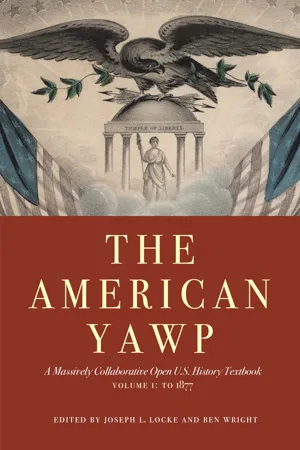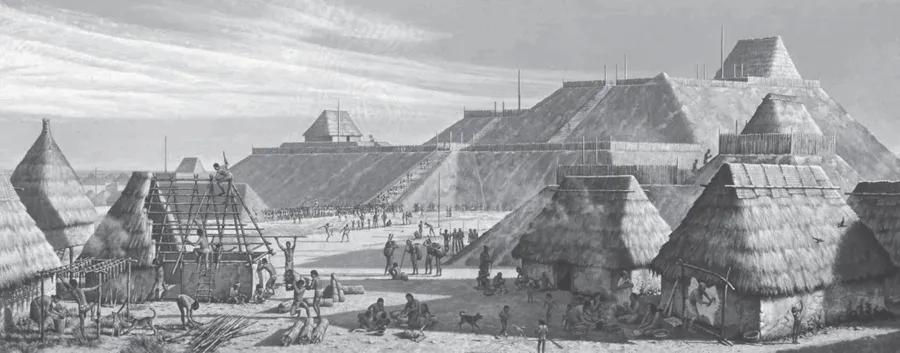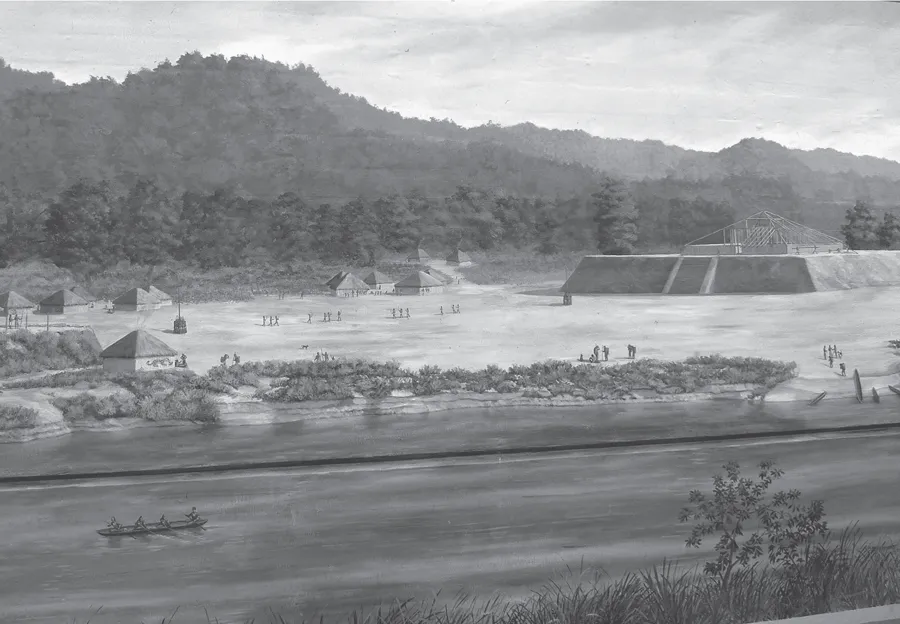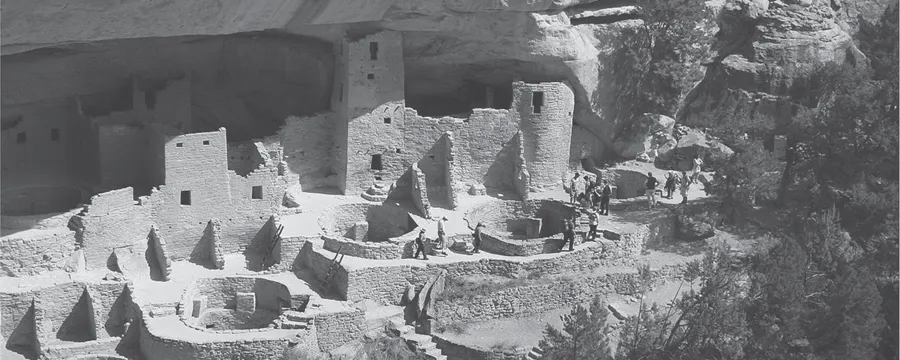![]()
1
The New World
Cahokia, as it may have appeared around 1150 CE. Painting by Michael Hampshire for the Cahokia Mounds State Historic Site.
I. Introduction
Europeans called the Americas “the New World.” But for the millions of Native Americans they encountered, it was anything but. Humans have lived in the Americas for over ten thousand years. Dynamic and diverse, they spoke hundreds of languages and created thousands of distinct cultures. Native Americans built settled communities and followed seasonal migration patterns, maintained peace through alliances and warred with their neighbors, and developed self-sufficient economies and maintained vast trade networks. They cultivated distinct art forms and spiritual values. Kinship ties knit their communities together. But the arrival of Europeans and the resulting global exchange of people, animals, plants, and microbes—what scholars benignly call the Columbian Exchange—bridged more than ten thousand years of geographic separation, inaugurated centuries of violence, unleashed the greatest biological terror the world had ever seen, and revolutionized the history of the world. It began one of the most consequential developments in all of human history and the first chapter in the long American yawp.
II. The First Americans
American history begins with the first Americans. But where do their stories start? Native Americans passed stories down through the millennia that tell of their creation and reveal the contours of indigenous belief. The Salinan people of present-day California, for example, tell of a bald eagle that formed the first man out of clay and the first woman out of a feather.1 According to a Lenape tradition, the earth was made when Sky Woman fell into a watery world and, with the help of muskrat and beaver, landed safely on a turtle’s back, thus creating Turtle Island, or North America. A Choctaw tradition locates southeastern peoples’ beginnings inside the great Mother Mound earthwork, Nunih Waya, in the lower Mississippi Valley.2 Nahua people trace their beginnings to the place of the Seven Caves, from which their ancestors emerged before they migrated to what is now central Mexico.3 America’s indigenous peoples have passed down many accounts of their origins, written and oral, which share creation and migration histories.
Archaeologists and anthropologists, meanwhile, focus on migration histories. Studying artifacts, bones, and genetic signatures, these scholars have pieced together a narrative that claims that the Americas were once a “new world” for Native Americans as well.
The last global ice age trapped much of the world’s water in enormous continental glaciers. Twenty thousand years ago, ice sheets, some a mile thick, extended across North America as far south as modern-day Illinois. With so much of the world’s water captured in these massive ice sheets, global sea levels were much lower, and a land bridge connected Asia and North America across the Bering Strait. Between twelve and twenty thousand years ago, Native ancestors crossed the ice, waters, and exposed lands between the continents of Asia and America. These mobile hunter-gatherers traveled in small bands, exploiting vegetable, animal, and marine resources into the Beringian tundra at the northwestern edge of North America. DNA evidence suggests that these ancestors paused—for perhaps fifteen thousand years—in the expansive region between Asia and America.4 Other ancestors crossed the seas and voyaged along the Pacific coast, traveling along riverways and settling where local ecosystems permitted.5 Glacial sheets receded around fourteen thousand years ago, opening a corridor to warmer climates and new resources. Some ancestral communities migrated southward and eastward. Evidence found at Monte Verde, a site in modern-day Chile, suggests that human activity began there at least 14,500 years ago. Similar evidence hints at human settlement in the Florida panhandle at the same time.6 On many points, archaeological and traditional knowledge sources converge: the dental, archaeological, linguistic, oral, ecological, and genetic evidence illustrates a great deal of diversity, with numerous groups settling and migrating over thousands of years, potentially from many different points of origin.7 Whether emerging from the earth, water, or sky; being made by a creator; or migrating to their homelands, modern Native American communities recount histories in America that date long before human memory.
In the Northwest, Native groups exploited the great salmon-filled rivers. On the plains and prairie lands, hunting communities followed bison herds and moved according to seasonal patterns. In mountains, prairies, deserts, and forests, the cultures and ways of life of paleo-era ancestors were as varied as the geography. These groups spoke hundreds of languages and adopted distinct cultural practices. Rich and diverse diets fueled massive population growth across the continent.
Agriculture arose sometime between nine thousand and five thousand years ago, almost simultaneously in the Eastern and Western Hemispheres. Mesoamericans in modern-day Mexico and Central America relied on domesticated maize (corn) to develop the hemisphere’s first settled population around 1200 BCE.8 Corn was high in caloric content, easily dried and stored, and, in Mesoamerica’s warm and fertile Gulf Coast, could sometimes be harvested twice in a year. Corn—as well as other Mesoamerican crops—spread across North America and continues to hold an important spiritual and cultural place in many Native communities.
Prehistoric settlement in Warren County, Mississippi. Mural by Robert Dafford, depicting the Kings Crossing archaeological site as it may have appeared in 1000 CE. Vicksburg Riverfront Murals.
Agriculture flourished in the fertile river valleys between the Mississippi River and the Atlantic Ocean, an area known as the Eastern Woodlands. There, three crops in particular—corn, beans, and squash, known as the Three Sisters—provided nutritional needs necessary to sustain cities and civilizations. In Woodland areas from the Great Lakes and the Mississippi River to the Atlantic coast, Native communities managed their forest resources by burning underbrush to create vast parklike hunting grounds and to clear the ground for planting the Three Sisters. Many groups used shifting cultivation, in which farmers cut the forest, burned the undergrowth, and then planted seeds in the nutrient-rich ashes. When crop yields began to decline, farmers moved to another field and allowed the land to recover and the forest to regrow before again cutting the forest, burning the undergrowth, and restarting the cycle. This technique was particularly useful in areas with difficult soil. But in the fertile regions of the Eastern Woodlands, Native American farmers engaged in permanent, intensive agriculture, using hand tools rather than European-style plows. The rich soil and use of hand tools enabled effective and sustainable farming practices, producing high yields without overburdening the soil.9 Typically in Woodland communities, women practiced agriculture while men hunted and fished.
Agriculture allowed for dramatic social change, but for some, it also may have accompanied a decline in health. Analysis of remains reveals that societies transitioning to agriculture often experienced weaker bones and teeth.10 But despite these possible declines, agriculture brought important benefits. Farmers could produce more food than hunters, enabling some members of the community to pursue other skills. Religious leaders, skilled soldiers, and artists could devote their energy to activities other than food production.
North America’s indigenous peoples shared some broad traits. Spiritual practices, understandings of property, and kinship networks differed markedly from European arrangements. Most Native Americans did not neatly distinguish between the natural and the supernatural. Spiritual power permeated their world and was both tangible and accessible. It could be appealed to and harnessed. Kinship bound most Native North American people together. Most peoples lived in small communities tied by kinship networks. Many Native cultures understood ancestry as matrilineal: family and clan identity proceeded along the female line, through mothers and daughters, rather than fathers and sons. Fathers, for instance, often joined mothers’ extended families, and sometimes even a mother’s brothers took a more direct role in child-raising than biological fathers. Therefore, mothers often wielded enormous influence at local levels, and men’s identities and influence often depended on their relationships to women. Native American culture, meanwhile, generally afforded greater sexual and marital freedom than European cultures. Women, for instance, often chose their husbands, and divorce often was a relatively simple and straightforward process. Moreover, most Native peoples’ notions of property rights differed markedly from those of Europeans. Native Americans generally felt a personal ownership of tools, weapons, or other items that were actively used, and this same rule applied to land and crops. Groups and individuals exploited particular pieces of land and used violence or negotiation to exclude others. But the right to the use of land did not imply the right to its permanent possession.
Native Americans had many ways of communicating, including graphic ones, and some of these artistic and communicative technologies are still used today. For example, Algonquian-speaking Ojibwes used birch-bark scrolls to record medical treatments, recipes, songs, stories, and more. Other Eastern Woodland peoples wove plant fibers, embroidered skins with porcupine quills, and modeled the earth to make sites of complex ceremonial meaning. On the Plains, artisans wove buffalo hair and painted on buffalo skins; in the Pacific Northwest weavers wove goat hair into soft textiles with particular patterns. Maya, Zapotec, and Nahua ancestors in Mesoamerica painted their histories on plant-derived textiles and carved them into stone. In the Andes, Inca recorders noted information in the form of knotted strings, or khipu.11
Two thousand years ago, some of the largest culture groups in North America were the Puebloan groups, centered in the current-day Greater Southwest (the southwestern United States and northwestern Mexico), the Mississippian groups located along the Great River and its tributaries, and the Mesoamerican groups of the areas now known as central Mexico and the Yucatán. Previous developments in agricultural technology enabled the explosive growth of the large early societies, such as that at Tenochtitlán in the Valley of Mexico, Cahokia along the Mississippi River, and in the desert oasis areas of the Greater Southwest.
Native peoples in the Southwest began constructing these highly defensible cliff dwellings in 1190 CE and continued expanding and refurbishing them until 1260 CE before abandoning them around 1300 CE. Andreas F. Borchert, Mesa Verde National Park Cliff Palace. Wikimedia. Creative Commons Attribution-Share Alike 3.0 Germany.
Chaco Canyon in northern New Mexico was home to ancestral Puebloan peoples between 900 and 1300 CE. As many as fifteen thousand individuals lived in the Chaco Canyon complex in present-day New Mexico.12 Sophisticated agricultural practices, extensive trading networks, and even the domestication of animals like turkeys allowed the population to swell. Massive residential structures, built from sandstone blocks and lumber carried across great distances, housed hundreds of Puebloan people. One building, Pueblo Bonito, stretched over two acres and rose five stories. Its six hundred rooms were decorated with copper bells, turquoise decorations, and bright macaws.13 Homes like those at Pueblo Bonito included a small dugout room, or kiva, which played an important role in a variety of ceremonies and served as an important center for Puebloan life and culture. Puebloan spirituality was tied both to the earth and the heavens, as generations carefully charted the stars and designed homes in line with the path of the sun and moon.14
The Puebloan people of Chaco Canyon faced several ecological challenges, including deforestation and overirrigation, which ultimately caused the community to collapse and its people to disperse to smaller settlements. An extreme fifty-year drought began in 1130. Shortly thereafter, Chaco Canyon was deserted. New groups, including the Apache and Navajo, entered the vacated territory and adopted several Puebloan customs. The same drought that plagued the Pueblo also likely affected the Mississippian peoples of the American Midwest and South. The Mississippians developed one of the largest civilizations north of modern-day Mexico. Rou...



